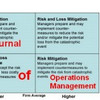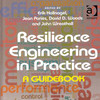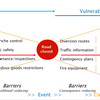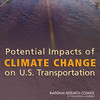 Supply chain disruption – a global issue? All companies and governments dependent on external suppliers are exposed to the risks of disruption in their supply chain. But the extent and complexity of current global supply chains mean that the problem of supply chain management is not limited to a single enterprise or industry: even a relatively small supply chain disruption caused by a global risk event may ultimately have consequences across the global economic system.
Supply chain disruption – a global issue? All companies and governments dependent on external suppliers are exposed to the risks of disruption in their supply chain. But the extent and complexity of current global supply chains mean that the problem of supply chain management is not limited to a single enterprise or industry: even a relatively small supply chain disruption caused by a global risk event may ultimately have consequences across the global economic system.
Four major challenges for 2008
Global Risks 2008, a report prepared by the World Economic Forum, maybe an unlikely source of information on supply chain risks, or maybe a particular source of information in this era of globalization, looks at global risks from a range of different perspectives.
The report focuses on four emerging issues that are shaping the global risk landscape:
- systemic financial risk
- food security
- supply chains
- energy
Supply Chain Risks for 2008
On supply chains, the report investigates a hidden set of vulnerabilities in the global economy and their affect to supply chain disruption:
Let me highlight some excerpts from the report concerning supply chain disruptions:
All companies and governments dependent on external suppliers are exposed to the risks of
disruption in their supply chain. But the extent and complexity of current global supply chains mean that the problem of supply chain management is not limited to a single enterprise or industry: even a relatively small supply chain disruption caused by a global risk event may ultimately have consequences across the global economic system.
Akin to the infamous “Butterfly effect”, your minor disruption could have major and global implications. Or conversely, some other company’s disruption may affect you severely, even though you in no (business) way are connected to said company.
However, despite their importance both at the level of individual enterprises and at the level of the global economic system, vulnerabilities to the supply chain are generally poorly understood and managed. This is partly because the risks in the supply chain are obscured, as enterprises and governments may be indirectly exposed to a global risk disruption through
a complex range of sub-supplier arrangements. But in some measure this is due to the range of possible global risk disruptions – from geopolitical risk to a natural catastrophe to pandemics. A US- or European-based company which sources key components from Asia will indirectly face risks that they may never encounter domestically, as well as very different cultural approaches to the management of risk.
As supply chains grow more and more complex and intertwined, the risk of cross-contamination from risky supply chains to secure/safe supply chains increases, and managing risks, and in particular disruptions, can become very difficult, if cultural barriers add to the confusion and lack of common understanding and consensus of what should be done:
The fragmentation of ownership of global risks and the complexity of interdependencies will make equitable and sustainable management of global risks hugely
challenging.
The looming financial crisis
The report was published early in 2008 and given the current global economic state and fears of economic recession as of July 2008 I could not help but notice this:
Should systemic financial risk lead to a serious deterioration in the world economy, the prospects for collaborative (risk) mitigation may be reversed on several fronts simultaneously as attention turns to more immediate concerns.
Does this mean that supply chain disruptions are likely to increase now, as companies and governments are struggling to keep the economy afloat?
You can read the full report here: Global Risks 2008
Reference
World Economic Forum (2008) Hyper-optimization and supply chain vulnerability: an invisible global risk? In: Global Risks 2008 – A Global Risk Network Report, REF: 090108, World Economic Forum, Switzerland.
Related
- husdal.com: AON Risk Map 2009
- husdal.com: Global Risks 2009












